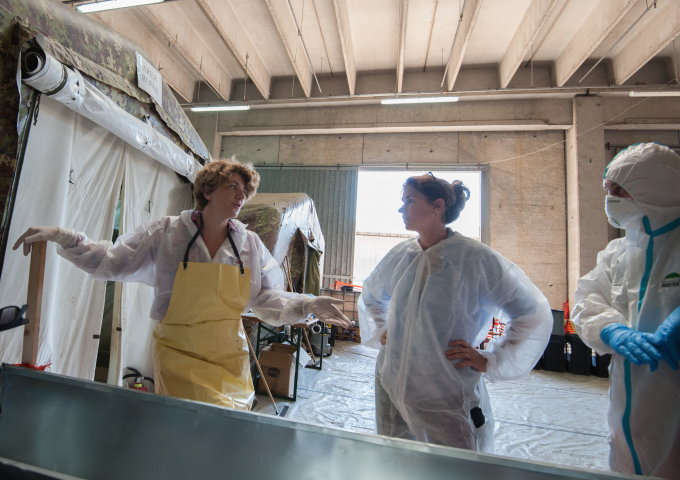
Dear Blog Readers –
I have disappeared from the blogosphere recently because I have been unable to keep up. I feel trapped in a whirlwind of news – stories to shoot, write, edit, tweets to send, and photos to post on instagam. I know, I know, I’m over the top. In addition I have been doing a lot of commentator work on the US Elections. I love US politics and during every election year I go on Italian TV to talk about the dynamics of the election campaigns, the candidates, and the politics. Also, over the past month I have been working on a big story for AP on the efforts of an extraordinary forensic pathologist from the University of Milan named Cristina Cattaneo to identify roughly 800 dead migrants from a ship that sank off the Libyan coast on April 18, 2015.
In order to get that story done for AP, over the past few weeks I had to remember what my father always taught me – keep your eye on the ball (see Blog Post “Keep Your Eye on the Ball”). Of course, being a mama-journo, I have the habit of trying to juggle many balls and not just keep my eye on one. (If you missed it, check out my post on my colleague juggling mama-journo Nicole Winfielf “Covering theVatican in her PJs“)
The AP story, a cross-format TV/Wire/Photo piece, finally came out on Friday. Here is the link if you are interested in reading the wire version. IDENTIFYING BODY NUMBER 421
And a little behind-the-scenes….
I started covering this story in April 2015 when I flew to Catania with a whole team from AP to cover the shipwreck. We filmed the 28 survivors arriving in the port, we filmed two boys from Bangladesh as they were being questioned by police to get their version of events at a center for minors near Catania, we covered the prosecutor’s press conference with his explanation of what had happened, and we spoke to the lawyer for the captain of the ship. We covered special masses, we spoke to relief workers, and volunteers and interviewed as many migrants as we could.
We did so much on that story I can barely remember it all and looking back at my old blog posts I have realized that I didn’t even have time to post about it. It was a devastatingly sad story to cover.
The Italian government made the decision to pull the ship up off the sea floor and bring the bodies back to Italy for identification and burial. Most of the details are in my story but stories for AP have to be fairly short, so I am posting a longer, unabridged version and a few photos.
For the first part of the story I visited Professor Cristina Cattaneo’s Labanof laboratory in Milan with AP cameraman Paolo Lucariello and AP photographer Antonio Calanni.
Then it took all sorts of bureaucratic pushing and shoving to get the permission to enter the navy base in Melilli, Sicily to film Professor Cattaneo and her team doing their work last weekend. Below are a few photos I took while I was there with AP video-journlist Mystslav Chernov and AP stringer Salvatore Cavalli.
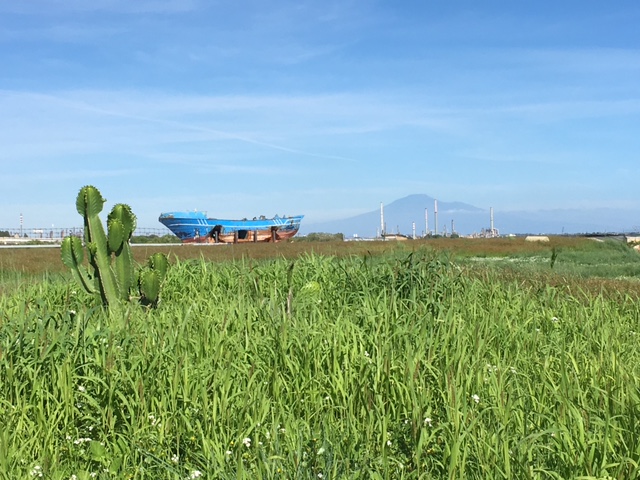
Forensic pathologist Cristina Cattaneo, wearing a white sanitary suit, latex gloves and a slime-covered yellow apron gripped a blue body bag and heaved it out of a refrigerated truck and onto a metal stretcher at the Mellili Navy base in Sicily. She then wheeled it into a temporary “morgue” tent where she began her work on the first stage of identifying the remains of a young male migrant. He is number 421.
Cattaneo, a professor at the University of Milan, is leading a team of forensic pathologists who have volunteered to identify and catalogue roughly 800 migrants who lost their lives in one of the worst tragedies in the Mediterranean migrant crisis. Her work is a unique, historic project expanding the field of humanitarian legal medicine and also a multi-million euro effort on the part of the Italian government to shame Europe into paying attention to migrants lost at sea and help Italy face the inundation.
After months of work, the team expects to complete the autopsies this month. In December the second stage of the process will begin, contacting relatives of those who had IDs on them, and reaching out to others who are looking for their missing kin.
On April 18th, 2015, the Italian Coast Guard received a call for help from a wooden fishing boat floundering 77 nautical miles off the Coast of Libya. When a freighter in the area was sent to the rescue, the frantic migrants on deck rushed to one side causing the fishing boat to capsize. The ship sunk to the bottom with hundreds of people trapped below deck. Eventually firefighters found five bodies for every square meter of the boat, 200 locked in the engine room alone. Their conditions were reminiscent of slave ships plying the seas in the 18th century—the migrants had clearly been trapped, unable to move. Only 28 people survived.
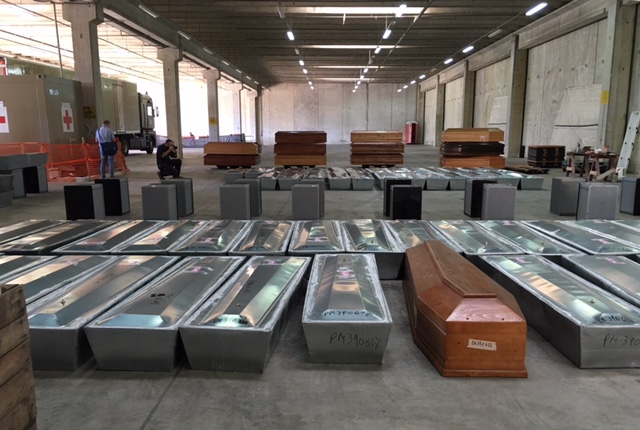
A pungent odor of death from putrefying corpses permeates the hangar where two morgue tents are set up. It clings to the clothing and hair of the living. Cattaneo doesn’t bother with the sanitary mask that many in the hangar are using. “I am used to it,” she shrugged. In the morgue tent, Cattaneo’s team pulled out the dark slime covered remains. There was rotting tissue and muscle covered in a black scum that encased some of the bodies and covered the pathologists’ aprons. One assistant used a sharp black-handled knife to cut off samples that required further study. They examined the muscles, bone structure, photographed the skull and teeth and took notes on a clipboard. Samples to be taken to their laboratory in Milan were separated from the parts that would be buried. Clipped to the sides of the tent were diagrams with different pelvic and skull structures to help give the team guidance.
After an hour Cattaneo emerged with a slimy pair of boy’s jeans with “Manchester United” written on them and carefully hosed them down. Keeping the items of clothing, and the personal effects found in the pockets is fundamental for the identification.
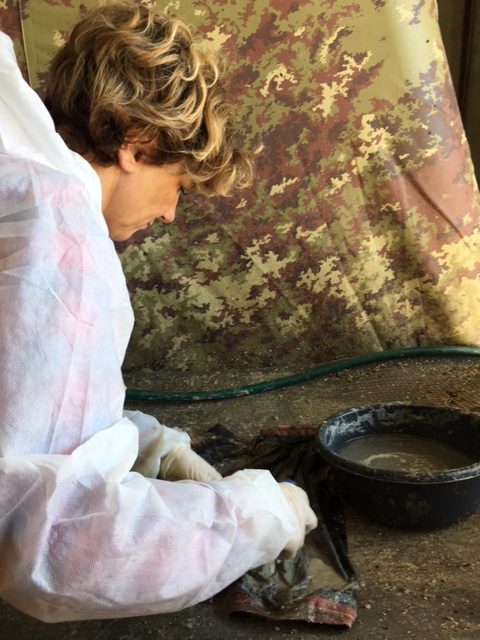
The body was given the serial number PM3900421. PM meaning Post Mortem, 39 for Italy and it was the 421st body.
When the autopsy was completed on PM3900421, the team wheeled the body bag out of the tent, and loaded it into a metal container that would go inside a wooden coffin for burial. Using a black magic marker, Cattaneo carefully wrote the serial number on the outside of the container and taped it to the side. A metal plate with this number will be nailed to the outside of the coffin and also placed above the grave.
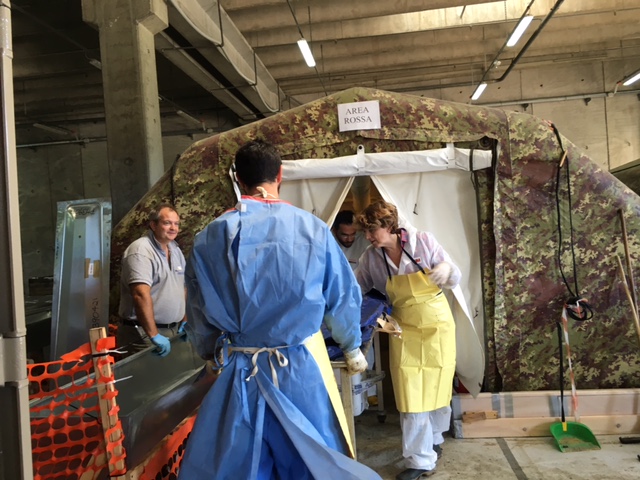
Standing by the body bag in the metal container Cattaneo explained that she wants to know the stories of the people who lost their lives and she learns pieces through the bodies and objects she finds on them. She believes identification gives dignity to a person and relief to their relatives. But the overall message is another, “This is what these people risk, many of these people end up like this,” she said gesturing towards the refrigerated truck with 90 body bags still inside.
Cattaneo said they will definitely reach 700 bodies and possibly “800 to 900 actual dead” from the shipwreck one they finish their work on the co-mingled remains in the laboratory. So far they have only found men, mostly between 12 and 27 years old.
Despite the tragedy, the business of trafficking in human lives shows no signs of letting up. Traffickers in Libya continue to reap a fortune by taking their cash then shoving migrants on top of each other in rickety vessels unfit to cross the Mediterranean. According to the International Organization for Migrants as of October 14th, 316,899 people have reached Europe by sea in 2016, and 3611 have either died or are missing.
Shortly after the shipwreck, Italian Premier Matteo Renzi announced that Italy would recover the sunken ship even if the operation were expensive. He said that the victims deserved a burial and he wanted to send a warning to Europe. His government allocated 9,5 million euros for the project. He has repeatedly called for the shipwreck to be placed in front of the EU office in Brussels as a reminder of the lives lost trying to reach Europe.
The Italian government has frequently called for the European Union to do more to Renzi to he test as he has faced domestic resistance from anti-immigrant parties and reluctance from EU partners to take asylum-seekers.
A year after the sinking, the Italian Navy, using a complicated pulley system fixed to a metal frame attached around the shipwreck, pulled it up to the surface and brought it to a Sicilian port. A crane then lifted the rusting carcass off the transport ship and put it on the dock.
Rear Admiral Paolo Pezzutti was responsible for the recovery operation. He stood on the deck watching as the shipwreck carcass was brought to the surface and said it was a “spectral vision” as the ship emerged from the deep, human remains sliding out through holes in the side of the boat.
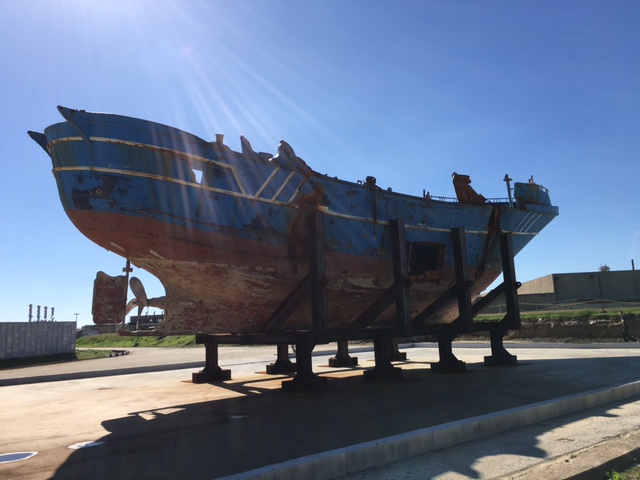
Once on the dock, firefighters in protective suits, rubber gloves, goggles and helmets cut into the rusted hull of the ship with hatchets and saws and put bodies – or mixed remains—into bags. Firefighters filled 458 body bags, but many of them contained the remains of more than one person.
Many migrants do not carry IDs because they want to circumnavigate a European regulation that requires migrants to request asylum in the first country of entry. Migrants who arrive by sea in Italy often want to head north to Germany, France or Sweden. Thus Cattaneo’s team must rely on DNA samples from the bones, teeth, and the objects found on the bodies.
At Cattaneo’s Labanof laboratory in Milan, little plastic bags and small cardboard boxes sit in neat lines along the table. Each one has the same serial number that was on the coffin. With her latex gloves on, Cattaneo goes over them one by one reviewing the belongings inside. These items were taken from the clothing of the migrants. She explained that many had their documents and photographs sewn into their clothing. In several bags there are little wooden sticks that migrants used for cleaning their teeth. Another has a photo of a saint, another what looks like a small brown candy in a pink wrapper – instead it is a spoonful of dirt brought from someone’s home.
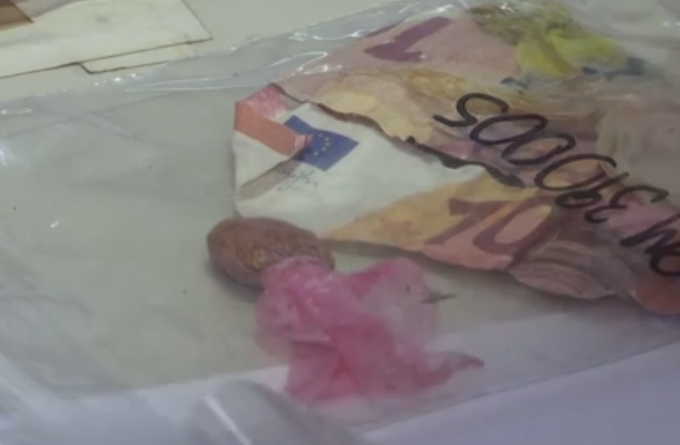
The dead in this shipwreck come from places where it is not easy to contact families – Somalia, Eritrea, Ethiopia, Guinea, Sudan, Senegal, Mali, the Ivory Coast and Bangladesh. Some of these countries have repressive governments; others have poor populations with little access to internet or phones.
Cattaneo is working with Italy’s office for Missing Persons run by High Commissioner Vittorio Piscitelli. The office has set up a database for migrants to identify their missing relatives. The database is a collection of post-mortem information, collected by Cattaneo and her team. Once the autopsies are completed they will start the next phase, collecting ante-mortem information provided by families searching for their loved ones. With both data inserted, experts then can compare such identifying features such as bone structure and teeth.
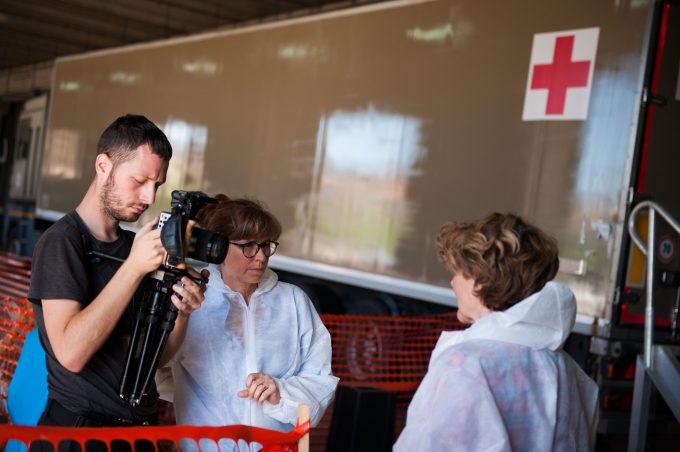
“This is the easier part,” explained Cattaneo. “The more challenging part is collecting what we call “ante-mortem” data. Ante-Mortem data include photos, videos, or detailed information on the migrants who are missing that can be compared to the post-mortem data.
Cattaneo said it is complicated to reach out to people in these countries for the information and then have the necessary authorities authenticate the identity of those providing it. “If we do not have people to show the data to, or any data to compare it with, we risk doing all this work in vain,” Piscitelli said.
So Piscitelli has reached out to the Red Cross and is now working with its office called “Restoring Family Links” which will try to make contact with the families of missing migrants. Diana Virgilio runs the “Restoring Family Links” office in Rome. She told the AP and once she has the list of IDs and information provided by the autopsies, her office will begin distributing their Missing Person forms and Tracing Requests to be filled out by families looking for relatives together with officials from their local Red Cross or Red Crescent offices. The forms ask for detailed information on the missing, including such details as “shape of ears, nose, and feet” and “scars, tattoos, birthmarks and moles”, “injuries, amputation, fractures bones.” They also ask for details on the circumstances leading to the disappearance. Although they have received some contacts from families directly, the Red Cross prefers that the relatives meet first with local officials who get the ante-mortem material from them.
Despite the difficulties in the process, Cattaneo is determined to carry on out of a sense of justice. She noted that in an air crash, train incident or cruise ship accident with European and American victims forensic experts rush to the scene and all the bodies are identified. But she points out that the migrants who lost their lives at sea remain in a “limbo,” “abandoned” with no one bothering to identify them. “These bodies become nobody’s business,” she sighed. “This is the largest mass disaster in Europe after the Second World War and it is the largest humanitarian crisis in terms of dead, unidentified bodies…but nothing has been happening for these people.”
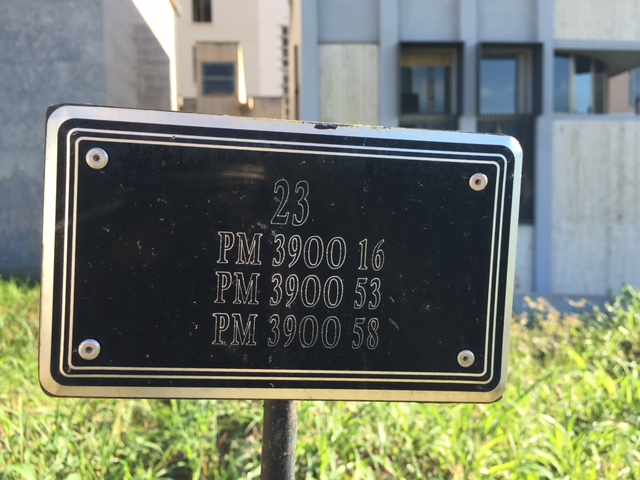
The final destination for the dead migrants is the cemetery in Catania. In an unkempt field lined with mounds of dirt, small black plaques list the serial numbers of the migrant bodies buried below. Some day the dead migrants’ relatives may be able to use Cattaneo’s database to put a name to a serial number and come find their lost relative.
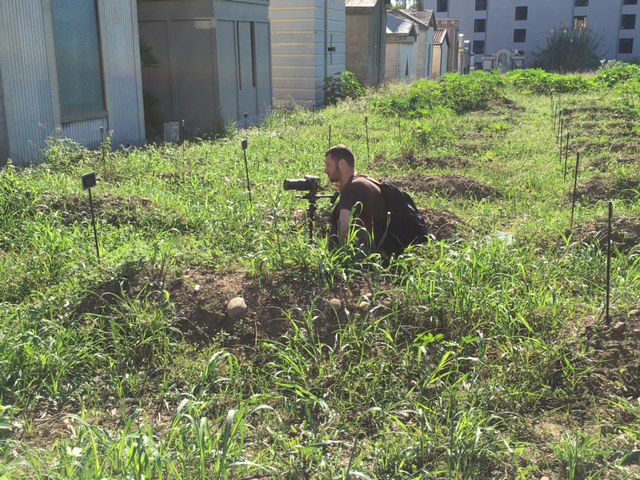
****************************************************************************
Small personal juggling mama-journo note. I got back from covering this story in Sicily late last Sunday night. The second US Presidential debate was on at 3am Italian time. I got up and watched it with with my dog Set because I had to go discuss it on SKY Italia the next morning. I found the first 15 minutes of the debate nauseating. Will go into why another time, but I think you all know. So after sitting through 1.5 hours of presidential debate, all I wanted to do was go back to bed. And what did Set do? He threw up everywhere. Poor dog, I think he’s had about enough of this presidential campaign and I can’t say I blame him.
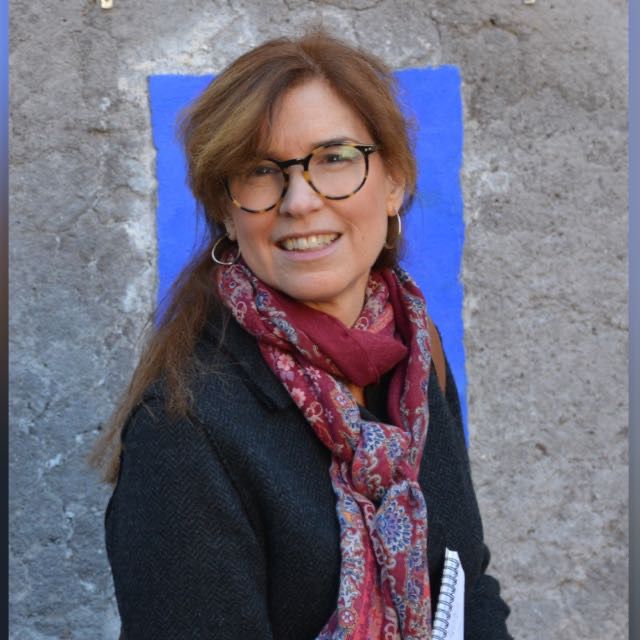
What a brilliant story. You bring out the best in journalism, Trisha. I really respect your writing and the stories in which you cover. Journalism these days seems to be corporate-sponsored (and I confess I work for one of those huge media conglomerates so I know what I am talking about) sensationalism. How I yearn for the days of Walter Cronkite. By the way, I am heading for Europe during election week – I plan to be away in the hills of Umbria while the country goes out of its mind November 8.
Heading for the hills!!! That sounds like a good idea. If you come through Rome, give me a call and we will have a coffee or an aperitivo! Yes, I also yearn for those Walter Cronkite days. The other day I gave a speech to a group about the US elections and at the end someone asked me if journalists, especially TV ones, are becoming dumber. He said they always ask such stupid questions these days and never seem to be concentrating when you see them on those TV talk shows. He noted that they often are looking at their Ipads or computers and are distracted. I totally agree with him. We are all so busy keeping up with twitter and on-line news, that we never step back and contemplate and think about issues and questions as was done in the Cronkite days. I must remind myself to do that — stop, think, contemplate, get off the social media!
Thank you, Trisha, for giving us a sad but necessary view of a problem we know little about. Also thank you for the story of the Italian people and government feeling the need for justice for these lost people. This is a most important and admirable part that most of us know nothing about. And thank you for writing this. I will save it to go back to the link.
In the meantime I’m with Set! I must admit I don’t watch the debates. I really don’t watch TV except for football. But then the next day, and most any day, I can’t tear myself away from reading about the election in the newspaper and online in several news sources.
Thanks again and a presto,
Joan
Thank you Joan. I am glad you enjoyed the article. I think it is a story that has attracted very little attention outside Italy and I am not sure why. Perhaps we are all too bombarded with news these days to keep track of anything. And it does seem that the American presidential election is dominating news coverage all over the world. I will be watching the last debate tonight — but I think you are smarter to stick with football!
Amazing people these forensic pathologists and their teams! From Sarajavo to the Med to so much of Africa to the teams of volunteers in Russia who recover and, where possible, identify the remains of German and Soviet soldiers and help bring closure for families and dignity to the dead. Unsung heroes to a man and woman so well done to you and AP for putting it out there.
Thanks Alan for mentioning some of the other important places/events where Forensic pathologists did a heroic job. I have never covered forensic pathologists before — Imagine the heroes behind the work on the Srebrenica massacre. Wow. They all have my full admiration.
Oh Trisha – How heartbreaking in so many ways. But what a hero Dr. Cattaneo is to do the work – the gruesome and important work – that she does to help identify those poor souls who lost their lives trying to reach freedom.
The photo you took of the ship with Etna in the background really is haunting.
I, and so many others, felt the same way as you (and your dog) did about the debate. Still, I’ll watch the third and final one, and probably wish I hadn’t.
I don’t know how you find the time to post even infrequently, with all that you juggle. I love reading your posts, even if they are only once a month or less often. Keep up the good work.
Linda, I really appreciate your support of my work and my blog. Yes, Professor Cattaneo is a true unsung hero. I hope my coverage gave a little more attention to what she is doing.
It is hard to keep juggling and I have let the blog slip a bit so I am happy to know I don’t lose loyal readers like you.
And yes, I also will be watching the final debate tonight — thank God it is the last. Let’s get this election over with ASAP!!
Trisha,
Thank you for covering this story, an unknown chapter for most of the world, with such a caring attitude. The work of Dott.essa Cattaneo is remarkable! Italy can scarce afford to deal with this crisis and yet it has devoted resources to do so.
You have helped restore the dignity of those lost by acknowledging the tragedy and not allowing us to forget.
Thank you Laurel — indeed Cristina Cattaneo is a remarkable woman and I am fascinated by her courage and her dedication to her work.
Thank you, dear Trisha, for All you do. I so appreciate your sharing whenever you can. No pressure from us. You don’t need any more.
Everyone’s comments above, and your replys say it all.
Your timing relative to the Italian State dinner at the WH seems perfect. Your post, so full of heart should go viral, and somehow be of help, to all who give so much on all ends of this tragedy.
THank you too Italy and her big hearted people,AP, the team, and of course…Set.
Please take care of yourself. We greatly appreciate you!
Annie
Annie — you are so sweet!! Thank you so much for your comment and your big boost. Boy do I wish I had an invite to that last State Dinner at the White House with the Obamas and the Renzis. I loved looking at the pictures and the video.
A very interesting story and I could’t agree with you more about paring life down to its essentials.
A story like this is worth more than blogs ultimately and you have raised our awareness with it.
Molto grazie!
Thank you Diane….really do need to start paring down a little more.
Thanks Dear Trisha. Its a very sad story, but too necesary to know for all of us. Thanks for your important job. Hugs from Chile, South America
Thank you Rossana!